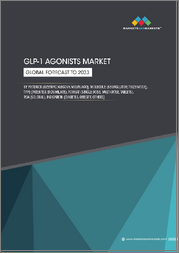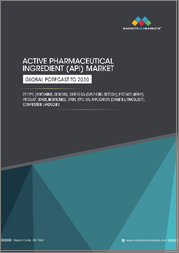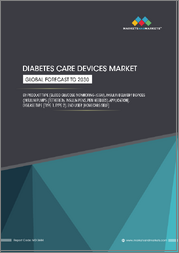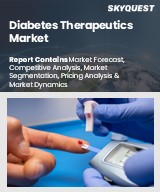
|
시장보고서
상품코드
1827425
당뇨병 치료제 시장 : 약물 종류별, 투여 경로별, 당뇨병 유형별, 약제 기원별, 유통 채널별 - 세계 예측(2025-2032년)Diabetes Drugs Market by Drug Class, Route Of Administration, Diabetes Type, Drug Origin, Distribution Channel - Global Forecast 2025-2032 |
||||||
당뇨병 치료제 시장은 2032년까지 CAGR 6.10%로 1,172억 5,000만 달러에 이를 것으로 예측됩니다.
| 주요 시장 통계 | |
|---|---|
| 기준 연도 2024년 | 729억 7,000만 달러 |
| 추정 연도 2025년 | 774억 달러 |
| 예측 연도 2032 | 1,172억 5,000만 달러 |
| CAGR(%) | 6.10% |
과학적 진보, 접근 역학, 상업적 수요를 결합하여 진화하는 당뇨병 치료제 전망에 대한 간결한 방향성 제시
당뇨병 치료제를 둘러싼 환경은 약제 클래스별, 약물전달 방식, 상업적 전략의 혁신에 힘입어 집중적인 진화의 시기를 맞이하고 있습니다. 지난 몇 년 동안 임상적 발전은 치료 패러다임을 재구성하고, 환자의 선호도와 지불자의 압력은 동시에 제조업체가 가치, 편의성, 순응도를 혁신하도록 이끌었습니다. 그 결과, 바이오제약 경영진부터 유통 파트너에 이르기까지 이해관계자들은 임상적 효과와 실질적인 접근성 및 비용의 조화를 이루기 위해 우선순위를 재조정하고 있습니다.
이 소개는 독자를 이러한 수렴하는 힘의 더 넓은 배경에 위치시키는 역할을 합니다. 치료 혁신과 공급망 및 상환의 구조적 변화와의 상호 작용을 강조하고 있습니다. 이어지는 서술에서는 과학과 상업화의 변혁적 변화를 탐구하고, 국경 간 영향을 미치는 관세 변경과 같은 정책적 영향을 평가하며, 세분화 및 지역적 역학을 리더를 위한 실용적인 인사이트로 전환합니다. 그 목적은 과학적 기회를 비즈니스 및 상업적 현실과 일치시키는 전략 개발을 위한 통합된 증거 기반 기반을 제공하는 것입니다.
과학의 발전,디지털 건강의 통합,공급망의 강인함이 당뇨병 치료제의 임상 및 상업적 전략을 재구성하는 방법
당뇨병의 상황은 개발 우선순위, 임상 관행, 상업적 모델을 변화시키는 몇 가지 상호 의존적인 힘에 의해 변화하고 있습니다. 인크 레틴 생물학과 펩타이드 치료제의 발전은 치료 알고리즘을 재정의하고, 치료 툴킷을 확장하며, 기존 기업들이 차세대 분자 및 전달 기술에 대한 투자를 촉진하고 있습니다. 동시에, 디지털 헬스 솔루션과 원격 모니터링은 데이터 기반 순응도 프로그램 및 지불자의 보험 적용과 가이드라인 채택에 있어 실제 증거의 역할을 증대시키고 있습니다.
공급망 강건성과 지역 제조에 대한 투자는 점점 더 전략적 우선순위가 되고 있으며, 기업들은 혼란에 대한 노출을 줄이기 위해 조달 발자국을 재평가하고 있습니다. 전략적 제휴와 플랫폼 라이선스 계약이 가속화되고 있으며, 중소 혁신기업은 대규모 자본 지출 없이도 규모를 확장할 수 있고, 대기업은 파이프라인을 확장할 수 있습니다. 이러한 변화는 경쟁을 심화시킬 뿐만 아니라, 환자 중심의 의료 제공 형태, 통합 진료 모델, 그리고 일회성 개입이 아닌 장기적 결과에 초점을 맞춘 차별화된 가치 제안을 통해 차별화의 창구를 창출합니다.
2025년 최근 관세 조정과 무역 정책의 변화로 인해 당뇨병 가치사슬 전반의 조달, 가격 책정 및 공급망 전략이 어떻게 재구성되었는지 평가합니다.
2025년 무역 및 관세 제도의 정책적 변화는 당뇨병 생태계에서 제조업체, 유통업체, 지불자에게 새로운 복잡성을 가져와 조달, 가격 책정, 재고 전략의 재평가를 촉구하고 있습니다. 관세 조정으로 인해 최종 제제 및 원료의약품의 상륙 비용이 상승할 수 있기 때문에 조달팀은 공급업체를 재검토하고 공급 기반을 다양화하며 지역 제조 파트너에 대한 의존도를 높여 노출을 줄여야 합니다. 결과적으로, 기업은 마진과 공급의 연속성을 유지하면서 가격 경쟁력을 유지하기 위해 이러한 결정은 지불자 및 조달 기관과의 계약 역학에 영향을 미치게 됩니다.
직접적인 비용 효과뿐만 아니라 관세로 인한 공급망 대응은 제조 능력에 대한 지역 투자를 가속화하여 장기적인 경쟁적 포지셔닝에 영향을 미칠 수 있습니다. 규제 대응, 통관 타임라인, 문서화 요구사항은 공급망 팀에게 중요한 분야가 되었습니다. 관세 시나리오를 적극적으로 모델링하고, 유연한 조달, 다원산지 조달 전략, 근해 제조 옵션을 도입하는 기업은 정책적 충격을 흡수하고 지역 간 시장 접근을 유지하는 데 유리한 위치에 서게 될 것입니다.
약물군, 투여 경로, 환자 유형, 원산지, 유통 채널에 따른 다차원적 세분화 인사이트로 임상 및 상업적 우선순위를 결정합니다.
세분화를 통해 임상적 요구, 상업적 기회, 업무적 요구사항이 교차하는 지점을 명확히 하고 전략적 계획을 수립할 수 있습니다. 약제 종류별로는 아밀린 유사체, GLP-1 수용체 작용제, 인슐린, 경구용 당뇨병 치료제(OADs)가 있으며, 인슐린은 다시 장시간 작용형과 단시간 작용형으로 나뉩니다. 펩타이드 기반 인크레틴 요법은 지속성과 대사적 이점을 강조하는 반면, 인슐린 제제는 제제 동역학에 따른 차별화된 전달과 콜드체인에 대한 고려가 필요합니다.
목차
제1장 서문
제2장 조사 방법
제3장 주요 요약
제4장 시장 개요
제5장 시장 인사이트
제6장 미국 관세의 누적 영향 2025
제7장 AI의 누적 영향 2025
제8장 당뇨병 치료제 시장 : 약물 종류별
- 아밀린 유사체
- GLP-1 수용체 작용제
- 인슐린
- 장시간 작용형
- 단시간 작용형
- 경구 당뇨병약(OAD)
제9장 당뇨병 치료제 시장 : 투여 경로별
- 흡입
- 주사제
- 경구
제10장 당뇨병 치료제 시장 당뇨병 종류별
- 1형 당뇨병
- 2형 당뇨병
제11장 당뇨병 치료제 시장 약물 기원별
- 브랜드 의약품
- 제네릭 의약품
제12장 당뇨병 치료제 시장 : 유통 채널별
- 재택 헬스케어
- 병원 약국
- 온라인 약국
- 소매 약국
제13장 당뇨병 치료제 시장 : 지역별
- 아메리카
- 북미
- 라틴아메리카
- 유럽, 중동 및 아프리카
- 유럽
- 중동
- 아프리카
- 아시아태평양
제14장 당뇨병 치료제 시장 : 그룹별
- ASEAN
- GCC
- EU
- BRICS
- G7
- NATO
제15장 당뇨병 치료제 시장 : 국가별
- 미국
- 캐나다
- 멕시코
- 브라질
- 영국
- 독일
- 프랑스
- 러시아
- 이탈리아
- 스페인
- 중국
- 인도
- 일본
- 호주
- 한국
제16장 경쟁 구도
- 시장 점유율 분석, 2024
- FPNV 포지셔닝 매트릭스, 2024
- 경쟁 분석
- Novo Nordisk A/S
- Eli Lilly and Company
- Sanofi S.A.
- AstraZeneca PLC
- Boehringer Ingelheim International GmbH
- Merck & Co., Inc.
- Novartis AG
- Pfizer Inc.
- Johnson & Johnson
- Bayer AG
The Diabetes Drugs Market is projected to grow by USD 117.25 billion at a CAGR of 6.10% by 2032.
| KEY MARKET STATISTICS | |
|---|---|
| Base Year [2024] | USD 72.97 billion |
| Estimated Year [2025] | USD 77.40 billion |
| Forecast Year [2032] | USD 117.25 billion |
| CAGR (%) | 6.10% |
A succinct orientation to the evolving diabetes therapeutics landscape that connects scientific advances, access dynamics, and commercial imperatives
The diabetes therapeutics landscape is experiencing a period of concentrated evolution driven by breakthroughs in drug classes, delivery modalities, and commercial strategies. Over the past several years clinical advances have reshaped treatment paradigms, while patient preferences and payer pressures have simultaneously driven manufacturers to innovate on value, convenience, and adherence. As a result, stakeholders from biopharma executives to distribution partners are recalibrating priorities to reconcile clinical effectiveness with practical access and cost considerations.
This introduction situates readers within the broader context of these converging forces. It emphasizes the interplay between therapeutic innovation and structural shifts in supply chains and reimbursement. The narrative that follows explores transformative shifts across science and commercialization, assesses policy impacts such as tariff changes with cross-border implications, and translates segmentation and regional dynamics into practical insights for leaders. The goal is to provide an integrated, evidence-based foundation for strategy development that aligns scientific opportunity with operational and commercial realities.
How converging scientific advances, digital health integration, and supply chain resilience are reshaping clinical practice and commercial strategies across diabetes therapeutics
The diabetes landscape is being transformed by several interdependent forces that are altering development priorities, clinical practice, and commercial models. Advances in incretin biology and peptide therapeutics have redefined treatment algorithms and expanded the therapeutic toolkit, prompting incumbents to invest in next-generation molecules and delivery technologies. Concurrently, digital health solutions and remote monitoring have elevated the role of data-driven adherence programs and real-world evidence in shaping payer coverage and guideline adoption.
Supply chain resilience and regional manufacturing investments are increasingly strategic priorities, with companies re-evaluating sourcing footprints to reduce exposure to disruptions. Strategic collaborations and platform licensing deals are accelerating, enabling smaller innovators to scale without extensive capital outlay while allowing larger players to broaden their pipelines. These shifts heighten competition but also create windows for differentiation through patient-centric delivery formats, integrated care models, and differentiated value propositions focused on long-term outcomes rather than episodic interventions.
Assessing how recent tariff adjustments and trade policy shifts in 2025 have reconfigured sourcing, pricing, and supply chain strategies across the diabetes value chain
Policy shifts in trade and tariff regimes in 2025 have introduced new complexities for manufacturers, distributors, and payers in the diabetes ecosystem, prompting reappraisals of sourcing, pricing, and inventory strategies. Tariff adjustments can elevate landed costs for finished formulations and active pharmaceutical ingredients, prompting procurement teams to revisit supplier selection, diversify supply bases, and increase reliance on regional manufacturing partners to mitigate exposure. In turn, these decisions influence contracting dynamics with payers and procurement bodies as firms aim to preserve price competitiveness while protecting margin and supply continuity.
Beyond direct cost effects, tariff-driven supply chain responses can accelerate local invest-ment in manufacturing capacity, influencing long-term competitive positioning. Regulatory compliance, customs clearance timelines, and documentation requirements have become focal areas for supply chain teams, as delays can propagate downstream to hospital pharmacies and outpatient access points. Companies that proactively model tariff scenarios and implement flexible sourcing, multi-origin procurement strategies, and near-shore manufacturing options will be better positioned to absorb policy shocks and sustain market access across geographies.
Multidimensional segmentation insights that align drug class, administration route, patient type, origin, and distribution channel to prioritize clinical and commercial priorities
Segmentation drives clarity in strategic planning by revealing where clinical need, commercial opportunity, and operational requirements intersect. Based on Drug Class, the landscape includes Amylin Analogs, GLP-1 Receptor Agonists, Insulin, and Oral Antidiabetic Drugs (OADs), with Insulin further delineated into Long Acting and Short-Acting categories. This framing highlights divergent development pathways: peptide-based incretin therapies emphasize durability and metabolic benefits, whereas insulin segments require differentiated delivery and cold-chain considerations tied to formulation kinetics.
Based on Route Of Administration, therapies span Inhalation, Injectable, and Oral formats, each carrying distinct adherence profiles, device development imperatives, and regulatory pathways. Delivery route choices drive patient experience and real-world persistence, and therefore directly influence positioning and reimbursement conversations. Based on Diabetes Type, the pipeline and product mix serve both Type 1 Diabetes and Type 2 Diabetes populations; clinical needs and care settings vary substantially between these cohorts, necessitating tailored engagement strategies for providers and payers.
Based on Drug Origin, offerings are categorized as Branded Drugs and Generic Drugs, a distinction that affects lifecycle management, price sensitivity, and competitive dynamics. Branded innovators focus on differentiation through outcomes and ancillary services, while generic entrants concentrate on cost leadership and supply continuity. Based on Distribution Channel, products reach patients through Home Healthcare, Hospital Pharmacy, Online Pharmacy, and Retail Pharmacy routes, and each channel imposes unique logistics, reimbursement, and patient education requirements. When these segmentation lenses are combined, they create a multi-dimensional view of opportunity and risk that supports prioritization of assets, channel strategies, and investment decisions.
Regional dynamics and differentiated access pathways across the Americas, Europe Middle East & Africa, and Asia-Pacific that determine regulatory strategy and supply choices
Regional dynamics continue to shape competitive agendas, regulatory strategies, and manufacturing footprints as diabetes care evolves across diverse healthcare ecosystems. In the Americas, market dynamics emphasize payer negotiations, integrated care pathways, and innovation adoption in both primary care and specialist settings. Reimbursement approaches and the role of pharmacy benefit managers impact formulary positioning and patient access programs, creating an environment where evidence of long-term outcomes and cost-effectiveness can unlock preferential placement.
The Europe, Middle East & Africa region offers heterogenous regulatory landscapes and procurement models, with some countries emphasizing centralized tendering and others relying on decentralized reimbursement decisions. This diversity requires tailored regulatory strategies, localized evidence packages, and flexible pricing models to navigate public procurement, hospital purchasing, and national health system priorities. Similarly, Asia-Pacific presents a mix of high-growth demand centers, price-sensitive markets, and rapidly expanding domestic manufacturing capability. Local production and regulatory endorsement can significantly accelerate market entry, while cross-border trade policies and regional partnerships influence supply chain resilience and competitive dynamics. Across all regions, the interplay between local regulation, payer structure, and manufacturing location informs go-to-market sequencing and long-term investment choices.
How scientific pipeline depth, strategic alliances, and manufacturing integration are reshaping competitive positions and value propositions among leading diabetes players
Competitive dynamics among leading companies reflect a blend of deep scientific pipelines, strategic alliances, and manufacturing control. Established pharmaceutical firms continue to invest in lifecycle extensions, delivery innovations, and outcome-driven positioning to protect premium segments. Meanwhile, biotech players and specialty developers focus on breakthrough mechanisms and differentiated benefit-risk profiles that attract partnership interest and licensing arrangements.
Across the sector, companies are prioritizing vertical integration for critical components such as peptide synthesis and cold-chain logistics to reduce exposure to supply disruptions. Strategic alliances frequently couple small-molecule or biologic innovators with larger commercialization partners to accelerate scale and market access. Additionally, the rise of biosimilars and generics in key insulin segments has intensified competition on price and supply security, prompting incumbent companies to emphasize service-based differentiation, patient support programs, and bundled care solutions to sustain brand value.
Practical, cross-functional strategic moves that align R&D priorities, supply diversification, payer engagement, and digital integration to secure competitive advantage
Industry leaders must pursue a coordinated set of actions to translate technological and policy shifts into sustainable advantage. First, companies should align R&D priorities with unmet clinical needs and payer evidence requirements, investing in endpoints that demonstrate durable outcomes and cost offsets over time. In parallel, portfolio managers should evaluate route-of-administration innovations and device synergies that can meaningfully enhance adherence and differentiate offerings in crowded therapeutic classes.
Operationally, firms need to diversify sourcing and accelerate regional manufacturing capabilities to hedge against tariff and trade volatility while shortening lead times for critical ingredients. Commercial teams should deepen engagement with payers and health systems to co-design value agreements and outcomes-based contracts that reflect real-world performance. Moreover, cross-functional investments in digital adherence platforms and remote monitoring should be scaled to support clinical claims with real-world data and strengthen patient retention. Finally, organizations should pursue selective partnerships and licensing arrangements to access complementary capabilities rapidly, balancing internal development with external innovation to maintain agility.
A transparent mixed-methods research approach integrating expert primary interviews, secondary literature review, and scenario-based triangulation to ensure actionable insights
The research approach combines structured primary research with rigorous secondary analysis and methodological triangulation to ensure robustness and practical relevance. Primary inputs included interviews with clinical experts, supply chain leaders, commercial executives, and payers to capture forward-looking perspectives on therapeutic adoption, reimbursement dynamics, and operational priorities. These qualitative insights were triangulated with regulatory filings, peer-reviewed clinical literature, and company disclosures to validate technical claims and development trajectories.
Data synthesis employed scenario analysis to test supply chain and policy sensitivities, while thematic coding distilled recurring strategic imperatives across stakeholders. Quality controls included cross-validation of interview findings with public filings and expert peer review to mitigate bias. Limitations include variability in regional reporting standards and the evolving nature of policy environments; the methodology addresses these by emphasizing scenario-based guidance rather than prescriptive numeric forecasts and by documenting assumptions that underpin strategic implications.
Concluding synthesis of strategic imperatives that combine clinical differentiation, operational resilience, and payer-aligned value to secure long-term positioning
In summary, the diabetes therapeutics domain is at an inflection point where scientific innovation, patient-centered delivery, and policy dynamics intersect to redefine competitive and operational priorities. Stakeholders who integrate deep clinical differentiation with resilient supply strategies and payer-aligned value propositions will be best positioned to capture sustainable advantages. The dual focus on real-world evidence and patient experience will increasingly determine which therapies achieve broad adoption and preferred positioning within constrained reimbursement environments.
Leaders should view the current environment as an opportunity to accelerate investments in differentiated delivery formats, regional manufacturing, and outcome-focused engagements. Those that act decisively to align clinical development with commercial access imperatives and operational resilience will create defensible positioning in an increasingly complex global landscape.
Table of Contents
1. Preface
- 1.1. Objectives of the Study
- 1.2. Market Segmentation & Coverage
- 1.3. Years Considered for the Study
- 1.4. Currency & Pricing
- 1.5. Language
- 1.6. Stakeholders
2. Research Methodology
3. Executive Summary
4. Market Overview
5. Market Insights
- 5.1. Rising adoption of SGLT2 inhibitors for cardio-renal risk reduction in type 2 diabetes management
- 5.2. Rapid expansion of GLP-1 receptor agonists utilization for weight loss and glycemic control in type 2 diabetes therapy
- 5.3. Proliferation of biosimilar insulin products reshaping pricing dynamics and market access in global diabetes care
- 5.4. Integration of continuous glucose monitoring data with insulin pumps driving personalized diabetes treatment strategies
- 5.5. Emergence of oral insulin delivery platforms aiming to improve patient adherence and reduce injection dependency
- 5.6. Increasing use of real-world evidence supporting combination therapy approvals in diabetes drug development pipelines
- 5.7. Adoption of AI-driven insulin dosing algorithms enhancing glycemic management through predictive analytics insights
- 5.8. Development of microbiome-targeted agents as novel adjunctive therapies addressing metabolic pathways in diabetes
6. Cumulative Impact of United States Tariffs 2025
7. Cumulative Impact of Artificial Intelligence 2025
8. Diabetes Drugs Market, by Drug Class
- 8.1. Amylin Analogs
- 8.2. GLP-1 Receptor Agonists
- 8.3. Insulin
- 8.3.1. Long Acting
- 8.3.2. Short-Acting
- 8.4. Oral Antidiabetic Drugs (OADs)
9. Diabetes Drugs Market, by Route Of Administration
- 9.1. Inhalation
- 9.2. Injectable
- 9.3. Oral
10. Diabetes Drugs Market, by Diabetes Type
- 10.1. Type 1 Diabetes
- 10.2. Type 2 Diabetes
11. Diabetes Drugs Market, by Drug Origin
- 11.1. Branded Drugs
- 11.2. Generic Drugs
12. Diabetes Drugs Market, by Distribution Channel
- 12.1. Home Healthcare
- 12.2. Hospital Pharmacy
- 12.3. Online Pharmacy
- 12.4. Retail Pharmacy
13. Diabetes Drugs Market, by Region
- 13.1. Americas
- 13.1.1. North America
- 13.1.2. Latin America
- 13.2. Europe, Middle East & Africa
- 13.2.1. Europe
- 13.2.2. Middle East
- 13.2.3. Africa
- 13.3. Asia-Pacific
14. Diabetes Drugs Market, by Group
- 14.1. ASEAN
- 14.2. GCC
- 14.3. European Union
- 14.4. BRICS
- 14.5. G7
- 14.6. NATO
15. Diabetes Drugs Market, by Country
- 15.1. United States
- 15.2. Canada
- 15.3. Mexico
- 15.4. Brazil
- 15.5. United Kingdom
- 15.6. Germany
- 15.7. France
- 15.8. Russia
- 15.9. Italy
- 15.10. Spain
- 15.11. China
- 15.12. India
- 15.13. Japan
- 15.14. Australia
- 15.15. South Korea
16. Competitive Landscape
- 16.1. Market Share Analysis, 2024
- 16.2. FPNV Positioning Matrix, 2024
- 16.3. Competitive Analysis
- 16.3.1. Novo Nordisk A/S
- 16.3.2. Eli Lilly and Company
- 16.3.3. Sanofi S.A.
- 16.3.4. AstraZeneca PLC
- 16.3.5. Boehringer Ingelheim International GmbH
- 16.3.6. Merck & Co., Inc.
- 16.3.7. Novartis AG
- 16.3.8. Pfizer Inc.
- 16.3.9. Johnson & Johnson
- 16.3.10. Bayer AG



















